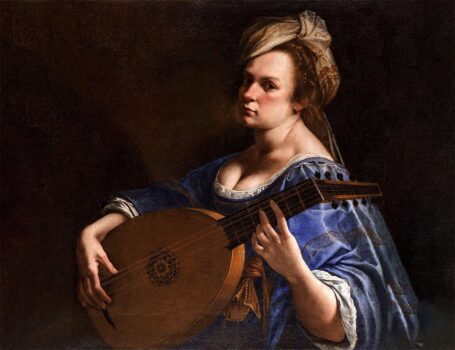Artemisia Gentileschi: The Brushstroke of Defiance and Triumph
In the history of art, few names carry the weight of rebellion, resilience, and radical beauty quite like Artemisia Gentileschi. Born into the chiaroscuro-drenched world of Baroque Italy, Artemisia’s art was not only a defiant answer to the patriarchy of her time, it was a masterclass in storytelling through canvas. Her paintings weren’t merely portraits or biblical scenes; they were raw, unapologetic narratives of trauma, power, and womanhood.
Today, Gentileschi stands among the most important female painters in Western art history. Her legacy, once obscured by centuries of male-dominated narratives, has resurfaced in full brilliance. This is the story of Artemisia Gentileschi: her life, her art, her battles, and her place among the titans of painting.
The Early Life of Artemisia Gentileschi
Artemisia Lomi Gentileschi was born on July 8, 1593, in Rome, into a family of painters. Her father, Orazio Gentileschi, was a prominent follower of Caravaggio, the master of dramatic light and shadow. From an early age, Artemisia showed an extraordinary aptitude for painting, quickly outshining her brothers in their father’s workshop. Her style bore the intense realism and emotional gravitas of Caravaggio, but with a female perspective that would come to define her legacy.
She was painting professionally by her late teens, unusual and near-unthinkable for a woman at the time. But Artemisia’s artistic ascension was not without profound personal suffering.
A Trial That Shook Rome
In 1611, while still a teenager, Artemisia was abuse by Agostino Tassi, a colleague of her father’s and a painter hired to tutor her. The subsequent seven-month trial became a public spectacle. Artemisia was subjected to torture via thumbscrews to “verify” her testimony, while Tassi, despite overwhelming evidence, received a light sentence.
But instead of retreating into silence, Artemisia found a powerful voice through her art. Her trauma didn’t define her, it became a powerful undercurrent that shaped her work’s intensity and subject matter.
What Is Artemisia Gentileschi Known For?
Artemisia is best known for her strikingly emotional and realistic depictions of strong women from mythology, history, and the Bible. Unlike her male contemporaries, she painted women not as passive subjects, but as complex protagonists, capable of strength, vengeance, and autonomy.
Themes of female empowerment, justice, and suffering dominate her most famous works. In particular, her repeated portrayals of Judith slaying Holofernes, a story from the deuterocanonical Book of Judith, are deeply symbolic. They’ve been interpreted as both an allegory for her personal trauma and a broader feminist declaration.
Her work is marked by:
Dramatic tenebrism (strong contrasts of light and dark),
Lush and realistic textures and colors,
And above all, deeply human emotion.
Most Famous Paintings by Artemisia Gentileschi
Several of her masterpieces have now gained worldwide acclaim. Here are some of her most iconic and powerful works:
1. Judith Slaying Holofernes (1614–20)
Probably her most famous work, this painting exists in two major versions: one in the Uffizi Gallery, Florence, and another in the Museo di Capodimonte, Naples.
It depicts the biblical heroine Judith beheading the Assyrian general Holofernes. The painting’s violent intensity, dynamic composition, and psychological realism distinguish it from other versions of the same theme, most notably that of Caravaggio. But Artemisia’s Judith is not coy or delicate. She is muscular, determined, and unflinching.
2. Susanna and the Elders (1610)
Completed when Artemisia was just 17, this early painting already displays her maturity as an artist. It depicts the biblical story of Susanna, a virtuous woman harassed by two elders. Unlike the voyeuristic approach of many male artists, Artemisia paints Susanna’s discomfort and resistance, highlighting the oppressive male gaze.
3. Judith and Her Maidservant (1613–14 and later)
This painting shows Judith in the aftermath of the beheading, with her maidservant beside her, both cloaked in dramatic shadows. The women are tense, alert, and powerful. Versions of this composition exist in several museums, including the Detroit Institute of Arts.
4. Self-Portrait as the Allegory of Painting (La Pittura) (c. 1638–39)
Held by the Royal Collection in London, this is one of the earliest known self-portraits by a woman artist in the Western canon. Artemisia embodies the personification of “Painting” itself, merging her identity with her craft. It’s bold, intellectual, and revolutionary.
5. Lucretia (c. 1620–21)
Lucretia, a Roman noblewoman who committed suicide after being abuse, is another tragic but defiant heroine. Artemisia paints her with agony and dignity, once again returning to themes of violence and virtue.
How Many Paintings Did Artemisia Gentileschi Create?
Artemisia’s exact oeuvre is still the subject of scholarly debate due to attribution issues and historical gaps. As of recent cataloging, approximately 60 to 70 paintings are attributed with varying degrees of certainty.
However, more works are occasionally discovered or reattributed, as interest in her art continues to surge. Her known paintings span from religious and mythological scenes to portraits and allegories, all underscored by her distinct emotional realism.
What Is the Most Expensive Painting by Artemisia Gentileschi?
In 2018, Artemisia’s “Lucretia” sold for approximately €4.8 million ($5.3 million USD) at auction, a record for her work at the time. The painting was celebrated not just for its poignant subject matter but also as a symbol of the growing market value of female Old Masters.
Given the rising demand for her work and the scarcity of authenticated paintings, it is expected that future auctions may exceed this amount.
Where Are Artemisia Gentileschi’s Paintings Located Today?
Artemisia’s paintings are held in some of the most prestigious art collections across the globe. Here’s where some of her key works can be found:
Italy
Uffizi Gallery, Florence – Judith Slaying Holofernes
Museo di Capodimonte, Naples – Second version of Judith Slaying Holofernes
Palazzo Pitti, Florence – Various religious works
United Kingdom
National Gallery, London – Self-Portrait as Saint Catherine of Alexandria
Royal Collection, London – Self-Portrait as the Allegory of Painting
United States
Detroit Institute of Arts – Judith and Her Maidservant
The Metropolitan Museum of Art, New York – Esther Before Ahasuerus
Getty Museum, Los Angeles – Lucretia
France
Musée des Beaux-Arts de Marseille – Clio, Muse of History
Germany
Gemäldegalerie, Berlin – Susanna and the Elders
Many of her works also appear in private collections, some only rediscovered in the last few decades.
What Is Artemisia Gentileschi’s Legacy?
Artemisia Gentileschi’s legacy is multifaceted and increasingly recognized:
1. Pioneer for Women Artists
As the first woman admitted to the Academy of the Arts of Drawing in Florence, Artemisia broke gender barriers and earned respect as a professional artist during a time when women were largely excluded from public life and artistic institutions.
2. Feminist Icon
Her paintings have become symbols of feminist resistance and female empowerment, particularly those like Judith Slaying Holofernes and Lucretia. Her ability to reclaim and reinterpret stories of women through a woman’s gaze has made her a powerful figure for modern feminist movements.
3. Master of Baroque Art
Beyond her gender, Artemisia is celebrated purely on artistic merit. Her use of dramatic lighting, emotionally charged figures, and dynamic compositions places her alongside Caravaggio, Rubens, and Rembrandt in the Baroque pantheon.
4. Cultural Renaissance
Since the 20th century, Artemisia has seen a massive resurgence in scholarly and popular interest. Exhibitions in major museums, scholarly reappraisals, and films have helped reclaim her rightful place in art history.
In 2020, the National Gallery in London hosted a landmark solo exhibition, featuring over 30 of her works, an unprecedented event for a female Baroque painter.
Artemisia in Popular Culture
Artemisia’s story has inspired books, plays, documentaries, and films, most notably:
“Artemisia” (1997) – A controversial French film based on her life.
“The Passion of Artemisia” by Susan Vreeland – A historical novel exploring her artistic journey.
Countless academic biographies and art history texts now cite her as essential study.
Her name is now taught alongside the great masters, not as a footnote, but as a formidable, stand-alone genius.
A Voice That Echoes Across Centuries
Artemisia Gentileschi painted through pain, against the tide of societal norms, and with a voice that resonates even louder today. Her canvases are not relics, they are revolutions. They speak to survival, to the reclaiming of narrative, and to the transformative power of art.
She gave biblical and mythological heroines new life, not as side characters, but as the focal point of strength, rage, and redemption. And in doing so, she wrote herself into the fabric of art history.
Today, as we walk through galleries where her paintings hang in gold frames beneath vaulted ceilings, we don’t just see brushstrokes. We see a woman who dared, who endured, and who painted as if her life, and the truth, depended on it.
In Artemisia’s own words:
“My illustrious lordship, I’ll show you what a woman can do.”
And indeed, she did.




